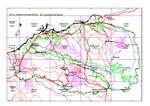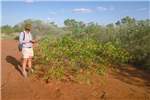Botanical name
Acacia tumida var. kulparn M.W. McDonald, Austral. Syst. Bot. 16: 160, figs. 11 & 13 (2003)
Common name
Kulparn
Description
Multi-stemmed shrubs 0.5-2 (-3) m tall with drooping branchlets. Bark smooth. Branchlets glabrous, orange to light brown, not pruinose (but sometimes pruinose outside the Pilbara), often flexuose. New shoots with a dense layer of rusty brown, microscopic resin-hairs when first initiated (indumentum soon lost). Phyllodes (on adult plants) straight and dimidiate or sometimes moderately falcate, 6-12 cm long, 20-35 mm wide, thinly coriaceous, glabrous, bright green tinged yellow and not pruinose (varying to grey-green and lightly pruinose on some plants outside the Pilbara); longitudinal nerves numerous, fine and close together, occasional anastomoses often present, with 4-6 nerves more evident than the rest (sometimes interspersed with a few sub- prominent nerves); narrowed towards the non-spiny apex; pulvinus 4-5 (-8) mm long. Gland not prominent, located on upper margin of phyllode at distal end of pulvinus. Inflorescences similar to var. pilbarensis except racemes often shorter according to McDonald (2003); peduncles 4-8 mm long, glabrous; spikes 20-45 mm long, yellow to light golden, the flowers densely arranged. Flowers 5-merous; calyx small, deeply dissected. Pods narrowly oblong to linear, terete to sub-terete or sometimes flattened, sometimes slightly to moderately constricted between and over seeds, 3.5-12 cm long, 6-12 mm wide, coriaceous-crustaceous (could be misinterpreted as ±sub-woody), straight to curved, sometimes openly coiled or twisted, finely longitudinally wrinkled, light greyish brown or yellow-brown, sometimes pruinose outside the Pilbara. Seeds obliquely placed in pods, ellipsoid, 5-7 (-9) mm long, dark brown to black, glossy except slightly less shiny and often slightly paler coloured at centre of the seed (i.e. the areole and a band external to the pleurogram); aril folded and creamy.
Characteristic features
Multi-stemmed shrubs mostly 0.5-2 m tall. Branchlets glabrous, not pruinose (in Pilbara plants). Phyllodes large, 6-12 cm long, 20-35 mm wide, straight and dimidiate or sometimes moderately falcate, glabrous, bright green and not pruinose (varying to grey-green and lightly pruinose on some plants outside the Pilbara); finely longitudinal multi-striate with some nerves more evident than the rest, nerves mostly parallel but few anastomoses often present. Inflorescences racemose; peduncles glabrous; spikes yellow to light golden. Pods narrowly oblong to linear, terete to sub-terete or flattened, coriaceous-crustaceous (could be misinterpreted as ±sub-woody), finely longitudinally wrinkled, light greyish brown or yellow-brown, not pruinose (on Pilbara plants). Seeds dark brown to black, glossy; aril creamy.
Distribution and ecology
Occurs in the Tanami Desert, Northern Territory and Great Sandy Desert of Western Australia; outliers occur on the Dampierland Peninsula north of Broome in the western Kimberley region. Variety kulparn is rare in the Pilbara where it is known from just two populations (3 km apart) located on the north eastern boundary of the region on the edge of the Great Sandy Desert, about 100 km due northeast of Marble Bar. It grows on sand dunes, sand plains (the latter sometimes with surface ironstone pebbles).
Flowering and fruiting period
Flowers in June and July with mature pods occurring in October and November.
Variation
Many plants from inland areas have pruinose stems, branchlets, phyllodes and pods (McDonald 2003). However, pruinosity has not been observed on Pilbara plants.
Taxonomy
Acacia tumida comprises four varieties (see McDonald 2003) of which var. pilbarensis and var. kulparn occur naturally in the Pilbara; the former is by far the more common in the region. Pilbara plants of var. kulparn are most readily distinguished from those of var. pilbarensis by their shrubby growth form and generally lower stature, but their non-pruinose branchlets and bright green, relatively short, often dimidiate phyllodes and generally shorter racemes also help characterize the variety. According to McDonald (2003) var. kulparn coppices from ground level following fire, whereas var. pilbarensis does not. As noted under var. pilbarensis it is likely that var. tumida was introduced to the Pilbara in the 1970s and 1980 for mine site rehabilitation.
Notes
Variety kulparn is highly fire-tolerant with burnt plants rapidly resprouting from epicormic buds just below ground level; it normally flowers and fruits prolifically during the first season of regrowth (McDonald 2003).
Information on provenance trials and genetic diversity in var. kulparn is provided by McDonald (2003).
Australian Aborigines traditionally used the seeds of var. kulparn as a food source by roasting the mature seeds, grinding them into a flower, adding water to make a paste, then roasting the mix in coals to make damper (Lowe and Pike 1994 and Kenneally et al. 1996, cited by McDonald 2003). Green pods were also cooked in ashes and seed eaten.
Conservation status
Not considered rare or endangered.
Origin of name
The botanical name comes from the Latin tumida (swollen). Ferdinand von Mueller, who first described the species, did not indicate the reason for the epithet, but the type material shows ±terete pods which may account for his use of this name. The varietal epithet and common name, Kulparn, is taken from the traditional name used by the Walmajarri Aborigines from the Great Sandy Desert for this plant (Lowe and Pike 1994).
References
Kenneally, K.F., Edinger, D.C. and Willing, T. (1996). Broome and beyond: Plants and people of the Dampier Peninsula, Kimberley, Western Australia. pp. 256. (Department of Conservation and Land Management: Western Australia.)
Lowe, P. and Pike, J. (1994). Jilji, life in the Great Sandy Desert. pp. 147. (Magabala Books: Broome, Western Australia.)
McDonald, M.W. (2003). Revision of Acacia tumida (Leguminosae: Mimosoideae) and close allies, including description of three rare taxa. Australian Systematic Botany 16: 139-164.




